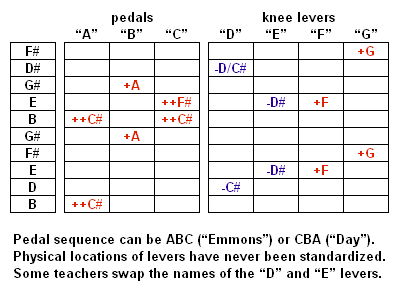![]()
The E9th is the most common of all pedal steel copedents. It is the sound that the general public associates with the instrument. It is used in all kinds of music, but it excels in country. E9th is the stock configuration of all single neck 10 string (S-10) pedal steels, and it is the front neck of double neck (D-10) instruments.
The E9th evolved during the late 1950s and 60s. By the mid 70s, major builders like Sho-Bud, Emmons, MSA and Sierra had settled on a standard set of 3 pedals and 4 knee levers.

The basic string tuning doesn’t vary much, but most people have personal preferences when it comes to extra pedals and knee levers. The “G” lever has evolved in several directions, to the point where the original changes can no longer be considered standard.
Some players use the E9th on a 12 string (S-12 or D-12) to extend its range into the low notes of the standard lead guitar. The 12-string E9th copedent, with low G# and E strings, is called “Extended E9th”.
Our archives demonstrate how players, some famous, some not, each have their own personal approach to the E9th copedent:
- Earnest Bovine (12)
- Jimmy Day *
- Michael Douchette
- Carl Dvorcek (12)
- Buddy Emmons *
- Paul Franklin *
- Mike Fried
- Jerry Gleason
- Lloyd Green *
- Jeff Newman *
- John Hughey *
- Johan Jansen
- Mike “The Cookie Monster” Jones
- Bobby Lee
- Jim Lindsey
- John McClung (12)
- Bob Shilling
- Sho~Bud Crossover
- Jack Stoner
- Tommy White *
* member of the International Steel Guitar Hall of Fame
Tom Bradshaw coined the term Copedent, and wrote about it in the ’70’s. Why not a credit to him mentioned here?
met him once very generous guy and very patient.
I believe you just did!
Bradshaw might be the nicest guy I’ve ever met
Back in the 70’s, in Chicago, I used to get off work and go listen to a pedal steel player named Butch Butler. He was playing in a group at a little place called Myron’s Playpen. I have completely lost track of him. To this day, he’s still the best player I’ve ever known. Any body ever hear of him, or know where he’s at? If this will help, there was another steel player named Russ Rickman, that we both hung out with. Thanks.
Marcus Bender
720-352-0965
mbender235@msn.com
I would ocassionally jam with that group Butch was with..the
sunday jam sessions, at the “playpen” a long time ago(1973-74)
when i was giggin’ around the Chicago area. Butch was one of
the first pedal guys who completely whacked me out. He, amongst
several others were the earliest influences on me becoming a
pedal steel guitarist. Marty, a keyboard player I worked with,
and I used to call him “Bitch Butch”. Back then anyone who was
a monster was a “bitch”. Butch Butler was indeed a monster.
Thanks for your blurb about this fine artist. I’ll be fondly
thinking about this all day…and beyond. Resp., JD
I played some gigs with Butch in the early 80’s he was indeed a great Steel Guitarist. I was told a few years back that Butch passed away.
Hello b0b,
What do the +, ++, – signify?
raise, double-raise, lower
I notice that Tommy White raises his 7th string to G on RKR. I am not quite seeing what that does musically. Any guidance deeply appreciated.
Gives you a 7#9 chord. Screams rock & roll! Can’t live without that!
It changes the pedals down A6th to A7th. Also, since he lowers string 9 to C# on the same lever, he has a diminished chord on strings 9 8 7.
Hello Bob, writing from: Sunshine Coast, Queensland in Australia. I have just purchased a well maintained 75/76 Fender Artist S-10 (3 Pedals & 4 Knee Levers). I believe it’s standard from the factory, and it’s co-pedent shown in the Owner’s Manual is almost the same as listed above for E9th, with the changes being: LKL-2xF, LKR-2xG, RKL-2xE, RKR-c# and G (The rod to pull this G is missing and I don’t know if it was like that from new). I believe these PSG’s were built by David Jackson for CBS Musical Instruments. Should I stay with the one shown in the Owner’s Manual and add the missing pull rod or go with something like the Lloyd Green setup (or something else)??
As you probably are aware, I am new to PSG’s but not new to 6 string guitar. I enjoy your site and find it very inspirational. Regards
Nothing wrong with that at all.
Very good instructions
What is the copedent for the knee levers on a Carter Starter. ?
See the owners manual.
thanks bob, just what I needed.
Hi, some great ressource here thanks! On a 1967 ZB D10, 8pedals/4knees, how many of those pedals/levers would be on each neck?
Typically, the E9th uses 3 pedals and all 4 knee levers. The C6th uses 5 pedals and adds its C to B change to one of the E9th levers (right knee).